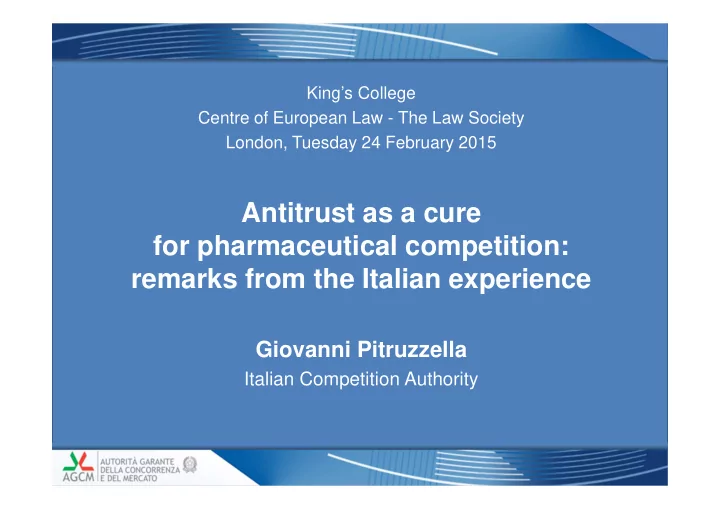

King’s College Centre of European Law - The Law Society London, Tuesday 24 February 2015 Antitrust as a cure for pharmaceutical competition: remarks from the Italian experience Giovanni Pitruzzella Italian Competition Authority 1 1
Outline 1 Introduction 2 On enforcement: the Xalatan Case 3 On Enforcement: the Avastin Case 4 On advocacy: the patent linkage issue 2
1. Sector inquiry (1/2 ) Introduction (1/2) • The relationships between pharmaceutical sector and antitrust have a rather long history, but in the recent years we observed an increasing number of interesting cases and the emergence of new issues – pivotal role of intellectual property issues – possible recurrence of divergent decisions (e.g. Lundbeck v. Actavis ) – relevant issues at stake from a broader viewpoint • The Italian Competition Authority (ICA) tries to be at the forefront of the new “pharmaceutical antitrust”
1. Sector inquiry on large food retail distribution (2/2) Introduction (2/2) • ICA’s enforcement activities in the last three years: -some relevant cases already closed - proceedings A431 Ratiopharm/Pfizer (see decision no. 23194 of January 11, 2012) - proceedings I760 Roche-Novartis/Farmaci Avastin e Lucentis (see decision no. 24823 of February 27, 2014) -three cases related to the pharmaceutical sector currently in the “pipeline” - proceedings A473 Fornitura acido colico (see decision no. 24674 of December 10, 2013) - proceedings I770 Arca/Novartis-Italfarmaco (see decision no. 24770 of January 29, 2014) - proceedings A480 Incremento prezzi farmaci Aspen (see decision no. 25186 of November 19, 2014)
2. Enforcement of competition law On enforcement: the Xalatan case (1/4) • The case in a nutshell - On January 2012 the ICA fined Pfizer group for an abuse of dominant position, pursuant to art. 102 of the Treaty of the functioning of the European Union (TFEU). - The relevant market was the Italian one of the medicines based on the active ingredient latanoprost for treating glaucoma. - The penalty established was € 10,6 million.
2. Enforcement of competition law On enforcement: the Xalatan case (2/4) - Pfizer’s behaviors were aimed mainly to protect its product’s market share from the entrance of generics following the expiry of Xalatan’s patent protection. - In Italy the relevant Xalatan patent was lacking a SPC extension. The ICA established that Pfizer obtained, then, a divisional patent for the same product and relied on this as a basic patent to obtain a SPC in Italy in order to realign the patent expiration time at a EU-wide level.
2. Enforcement of competition law On enforcement: the Xalatan case (3/4) - After having enhanced its protection strategy, Pfizer did not industrially develop any of its new patent rights. Rather, the company engaged itself in “vigorously” deterring the entry on the relevant market of targeted competitors (e.g. by issuing warnings to generics producers). - As a final result of Pfizer’s strategy the first entry into the market has been possible only in May 2010, while further operators entered the market after more than a year and a half after the end of the new patent protection. The harm provoked to the NHS has been consistent.
2. Enforcement of competition law On enforcement: the Xalatan case (4/4) - The assessment of the ICA has been upheld by the relevant administrative courts (cf. Consiglio di Stato, CdS, judgement no. 693 of February 12, 2014). - A very interesting issue raised by the CdS is the usability of an “abuse of power” framework within the antitrust assessment.
2. Enforcement of competition law On enforcement: the Avastin case (1/4) • The case in a nutshell - On February 2014 the ICA fined Roche and Novartis groups for an illicit agreement, pursuant to art. 101 of the TFEU. - The relevant market was the Italian one of the medicines used for curing some severe and widespread eye diseases. - The fines imposed were respectively € 92 million (Novartis group) and € 90,5 million (Roche group).
2. Enforcement of competition law On enforcement: the Avastin case (2/4) - Avastin is a registered product for the treatment of cancer, but from the mid-2000 has been widely used off-label for treating eye diseases. Lucentis is based on a molecule very similar to that of Avastin, but specially registered for treating eye diseases. - Significant cost difference between the two products: (Avastin € 81 v. Lucentis € 1700-900).
2. Enforcement of competition law On enforcement: the Avastin case (3/4) - The parent company Roche and Novartis embarked since at least 2011 in an artificial product differentiation strategy by presenting Avastin (when used in the eye) as more dangerous than Lucentis in order to condition medical choices. - Strong economic relationships existing among Roche and Novartis groups (licensing agreements, stakes) do explain, in the ICA’s view, the relevant conducts.
2. Enforcement of competition law On enforcement: the Avastin case (4/4) - The illicit agreement severely impaired the NHS ability to treat many patients and artificially increased healthcare expenditures. - The assessment of the ICA has been upheld by the first-degree administrative court (cf. TAR Lazio, decision no. 12168 of November 5, 2014). Further appeal is pending.
2. Enforcement of competition law On advocacy: the patent linkage issue (1/1) • Enforcement AND advocacy as the right way to protect/develop competition - Along with its enforcement activity, advocacy is fundamental (cf. articles 21-22 of Italian law no. 287/1990). - Patent linkage has already been criticized both by the EU Commission and the ICA, but the Italian legislator apparently forgot it: a recent ICA’s intervention (cf. recommendation S2025 of July 4, 2014) acted as a reminder.
2. Enforcement of competition law Thank you Prof. Giovanni Pitruzzella Autorità garante della concorrenza e del mercato Piazza Verdi 6/A 00198 Roma giovanni.pitruzzella@agcm.it
Recommend
More recommend